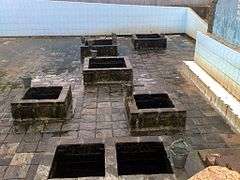Kanniya hot water spring
| Kanniya Hot water spring | |
|---|---|
 | |
| General information | |
| Status | Preserved |
| Architectural style | Hot springs |
| Location | Kanniya |
| Town or city | Trincomalee |
| Country | Sri Lanka |
| Coordinates | 08°36′16.2″N 81°10′16.8″E / 8.604500°N 81.171333°ECoordinates: 08°36′16.2″N 81°10′16.8″E / 8.604500°N 81.171333°E |
| Designations | Archaeological protected monument (9 September 2011) |
The Kanniya Hot Springs (Sinhalese: කන්නියා උණුදිය ලිං, Tamil: கன்னியா வெந்நீரூற்று) is a site with hot wells located in Trincomalee, Sri Lanka. There are seven wells in a square shape. Wells are only 3–4 feet deep and you can clearly see the bottom. The temperature is considerably high but vary slightly from one spring to another.[1] Wells run out of water, when 10-15 buckets of water are taken out.[2]
History
The old ruins of the monastery still visible over the area, but it seems that most of those artifacts were destroyed during the Sri Lankan Civil War.[3] On 9 September 2011, the seven hot water wells, Chaitya mound and other scattered building ruins in the site were formally recognised by the Government as an archaeological protected site in Sri Lanka. The designation was declared under the government Gazette number 1723.[4]
Legend
Religious Hindu rituals dedicated to lost loved ones are observed by the Sri Lankan Tamils at this site, believed in folklore to have been started by Ravana, antagonist of the epic Ramayana.[5] According to local folklore, is this site connected with the antagonist Ravana of the Hindu epic, Ramayana. Ravana and his mother worshipped Hindu God Shiva at the Koneswaram temple and the Hot springs of Kanniya. Ravana wanted to remove the temple of Koneswaram when his mother was in ailing health. Ravana was heaving the rock, Lord Shiva made him drop his sword. Ravanan mother heard that news and thought of unbeatable sorrow. When Ravana returns he found his beloved mother demise was disheartened. To do her mother's rites, Ravana stuck the earth with his sword in several spots and several fountains sprang from these points. The water was hot and this was the beginning of these hot water springs.[6]
Mahabharata, the Hindu epic notes that hot well is near Gokarna bay, in the middle of the ocean and is the island shrine of Uma's consort Shiva, known in the three worlds and worshipped by all peoples from the subcontinent, including the native tribes Naga, Deva and the Yaksha, the rivers, ocean and mountains.[7] It continues that the Koneshwara Temple and Hot water spring is the next pilgrimage spot for Hindus en route south following Kanyakumari of the early Pandyan kingdom and Tamiraparni island (Kudiramalai) and that worshippers should fast for three days at the temple.[8]
According to the local beliefs, the history of Kanniya hot water spring is dated back to the Ravana era and the first written references to a hot water spring near to Gokarna bay (Trincomalee) is said to be found in the epic Ramayana. However it is also believed that this wells were part of a Buddhist monastery and Buddhist monks used this place as a part of their complex.[3]
See also
Notes
- ↑ "Trinco's hot wells, forts, beaches, Koneswaram Kovil and dosa#Kanniya Hot Wells". The Sunday Times (Sri Lanka). Wijeya Newspapers. 28 July 2013. Retrieved 10 September 2017.
- ↑ History of Kanniya hot water wells
- 1 2 "Tourism Eastern Province#Kanniya Hot Water Spring". Eastern Provincial Council. Retrieved 10 September 2017.
- ↑ Gazette 1723 & 9 September 2011, p. 683.
- ↑ Rasanayagam, C.; Rasanayagam, Mudaliyar C. (1993). Ancient Jaffna: Being a Research Into the History of Jaffna from Very Early Times to the Portuguese Period. Asian Educational Services. p. 185. ISBN 9788120602106.
- ↑ Sivaratnam, C (1964). An outline of the cultural history and principles of Hinduism (1 ed.). Colombo: Stangard Printers. OCLC 12240260.
Koneswaram temple. Tiru-Kona-malai, sacred mountain of Kona or Koneser, Iswara or Siva. The date of building the original temple is given as 1580 BCE. according to a Tamil poem by Kavi Raja Virothayan translated into English in 1831 by Simon Cassie Chitty...
- ↑ Vyasa. (400 BCE). Mahabharata. Sections LXXXV and LXXXVIII. Book 3. pp. 46-47, 99
- ↑ "Listen as I now recount the isle of Tamraparni, gemmed upon the ocean. The gods underwent austerities there, in a desire to attain greatness. In that region also is the lake of Gokarna. Then one should go to Gokarna, renowned in the three worlds. O Indra among kings! It is in the middle of the ocean and is worshipped by all the worlds. Brahma, the Devas, the rishis, the ascetics, the bhutas (spirits or ghosts), the yakshas, the pishachas, the kinnaras, the great nagas, the siddhas, the charanas, the gandharvas, humans, the pannagas, rivers ocean and mountains worship Uma's consort there". Mahabharata. Volume 3. pp. 46–47, 99
References
- "PART I : SECTION (I) — GENERAL Government Notifications" (PDF). The Gazette of the Democratic Socialist Republic of Sri Lanka. 1723. 9 September 2011.